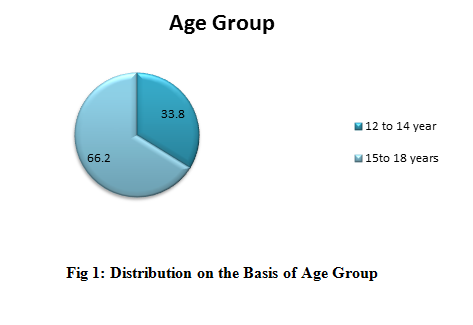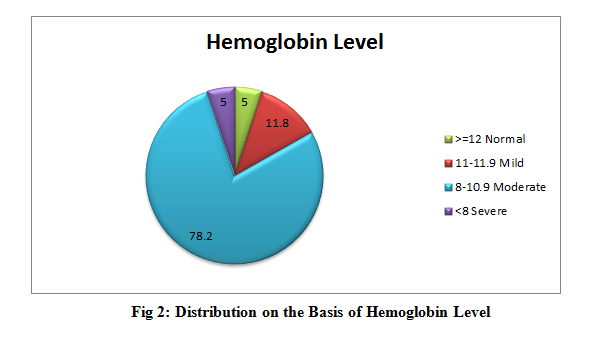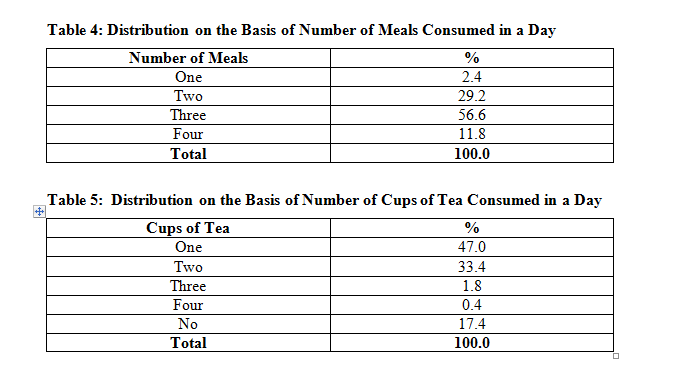Alleviation: An International Journal of Nutrition, Gender & Social Development, ISSN 2348-9340 Volume 1, Number 1 (2014), pp. 1 - 8
© Arya PG College, Panipat & Business Press India Publication, Delhi
www.aryapgcollege.com
Dietary Habits in Relation to Anemia among Adolescent Girls in Slum Areas of Chandigarh
Kalyani Singh, Monica Malik, Mamta Dangi
Assistant Professor, Department of Home Science (Foods and Nutrition), MCMDAV College, Chandigarh Associate Professor, Department of Foods and Nutrition, Government Home Science College, Chandigarh Post Graduate Student
Email: singh.kalyani26@yahoo.com
Introduction
The world’s adolescent population has been facing a series of serious nutritional challenges which are not only affecting their growth and development but also their livelihood as adults. Yet, adolescents remain a largely neglected, difficult- to- measure and hard -to- reach population, in which the needs of adolescent girls in particular, were often ignored. Inadequate nutrition during adolescence could have serious consequences throughout the reproductive years of life and beyond. The word adolescence is derived from the Latin word, ‘adolescere’; meaning “to grow”. Adolescence is a period of transition from childhood to adulthood. It has been defined as the period of life between 10-19 years (World Health Organization 1996). Adolescents constitute 21 per cent of Indian population. The nutritional and the health needs of the adolescents were also more because of the growth spurt and the increase in physical activity in them. In girls, adolescence marks the beginning of the menstrual cycle or reproduction. According to census 2011, the total population of Chandigarh was 1,054,686, out of which 580,282 were males and 474,404 were females (60 % reside in the urban areas, 30 % in urban slums and 10 % in rural areas). Decadal growth rate is 17.10 per cent. Chandigarh has 22 villages (13 were under Chandigarh Administration and 9 villages were under the Municipal Corporation). There were 41 urban slums and colonies in the city. In the literacy rate, Chandigarh is on 8th position. The sex ratio is 818/1000 males. Nutrition is the science of foods values. It is defined as the combination of process by which the living organism receives and utilizes the materials necessary for the maintenance of its functions and for the growth and renewal of its components. In addition nutrition must be concerned with social, economic, cultural and psychological implication of food and eating. Nutritional anemia refers to a condition in which the hemoglobin content of the blood is lower than normal resulting in a reduced oxygen carrying capacity of red blood cells. According to World Health Organization (WHO), Anemia has been defined as, Hemoglobin level less than 12mg/dl in female and less than 13mg/dl in male. Anemia has been an indicator of both poor nutrition and poor health. It reduces physical work capacity and cognitive function and adversely affects learning and scholastic performance in schoolgirls entering adolescence. Proper nutrition plays an important part in growth and development. Anemia is the result of a wide variety of causes that can be isolated, but more often coexist. The World Health Organization estimates that more than 1/3rd of world population was anemic, of which iron deficiency anemia (IDA) was most common and serious problem of public health significance. The main risk factors for IDA include a low intake of iron, poor absorption of iron from diets high in phytates or phenolic compounds, and period of life when iron requirements are especially high and heavy blood loss as a result of menstruation and stomach bleeding. Due to unhygienic conditions and unclean drinking water, children in peri-urban slums have been prone to helminthic disease (Caused by a parasitic worm), which do not allow absorption of iron. Acute and chronic infections, including malaria, cancer, tuberculosis and HIV can also lower blood Hemoglobin concentrations. The presence of other micronutrient deficiencies, including vitamins A and B12, foliate, riboflavin, and copper can increase the risk of anemia.
According to World Health Organization (2001), adequate nutrition of any individual is determined by factors like the adequate availability of food in terms of quantity as well as quality and also on the ability to digest, absorb and utilize the food which can be hampered by infection and by metabolic disorders. The term malnutrition is used to describe the state of the body when food and nutrient intake are either inadequate or excessive. Even though poverty remains a major cause of malnutrition, it was not the only limiting factor. Factors which have a direct bearing on the quality of life like ignorance, lack of awareness regarding the nutritive value of foods, inadequate sanitary environment, large family size, absence of a responsible adult care giver also contribute to malnutrition.
The nutritional status of the children depends on dietary habits. The malnutrition and repeated attack of infectious diseases are known to be important causes of poor health. It is of prime importance to identify those who are in the danger line so that appropriate measures may be taken for improvement particularly for the children of low income group. Due to the importance of eating breakfast, considerable research has been undertaken to explore the reasons given for skipping breakfast. Reported reasons for poor breakfast habits include stress, lack of time, or lack of parental control (Parents working outside the home or divorced parents). Skipping breakfast is typically more prevalent in girls, children from lower socio-economic backgrounds, older children and adolescents. In an attempt to draw a conclusion about the effect of tea on iron status, a wide variety of studies with different designs, from different countries, were carried out in different age and gender groups. Results from these studies are conflicting; some have found a higher risk of anemia amongst tea drinkers compared to non tea drinkers, while others have shown no such association, both in children and adults.
In view of the high prevalence of malnutrition and anemia reported among adolescent girls, the present study was undertaken to assess the incidence of anemia among adolescent girls and to examine the impact of dietary habits on anemia.
Methodology
In the present study “Dietary habits in relation to anemia among adolescent girls living in slum areas of Chandigarh were studied. Four slum areas– Indira colony, Sector 25 – D colony, Baapu Dham Colony (BDC) and Maulijaagra were selected. Data were collected from 500 adolescent girls in the age group of 12 – 18 years. These adolescent girls were further divided into 2 sub -groups based on their age as: Group I: 12 to 14 years (169 girls) and Group II: 15 – 18 years (331 girls). Purposive sampling technique was used to collect the data of girls living in slum. Data were collected from Indira colony dispensary, by home visiting and with the help of YTTS (NGO).
Methods Used for the Survey
Questionnaire-cum-interview method was used as it was appropriate for acquiring the necessary information
Self Designed Questionnaire
It was comprised of questions which were discussed, edited and re-edited. The questions were kept simple, unambiguous, and open and close ended that were arranged logically. Some questions were put to them in different manner so that the accurate information could be obtained from them in a polite manner. The questions were explained to some of the respondents in local language (Hindi) for their convenience and understanding.
This questionnaire contained information about demographic aspects, prevalence of anemia and dietary habits
Biochemical Analysis
Method used for hemoglobin testing: Blood samples were tested for hemoglobin level by using Drabkins Cyanmethemoglobin method with the help of technician.

Collection of Data
The sample for the study was selected from four different slum areas (Indira colony, BDC, Sector-25 D Colony and Maulijaagra). Their responses to various questions were recorded using interview method. Their initial interaction at the beginning helped to arouse interest of the subjects and to gain their cooperation. After this initiation, they were quite willing to give all necessary information
Statistical Analysis of Data Data were analyzed by using simple frequencies, percentages, arithmetic mean, standard deviation, ANOVA, t-test of significance and Chi-square test of association.
Results and Discussion
Age Group
It can be seen in Fig 1 that out of the sample of 500, 33.8 per cent of the respondents belonged to the age group of 12-14 years, while remaining 66.2 per cent belonged to the age group of 15-18 years. The mean age of the respondents was 15.9 years.

Hemoglobin Level
It can be analyzed from Fig 2 that 95 per cent of the respondents were anemic and only 5 per cent were non anemic. The prevalence of anemia was mild (11.8%), moderate (78.2%) and severe (5%). The mean hemoglobin level among the respondents was 9.9.

Eating Habits
It can be analyzed from Table 2 that there were 58.4 per cent of the respondents who were vegetarian, followed by non-vegetarian (29.2%) and ovatarian (12.4%).

Skipping Meal
It is highlighted in Table 3, that 73.4 per cent of the respondents consumed breakfast every day while the remaining respondents 26.6 per cent skipped breakfast. Out of 26.6 per cent respondents who skipped breakfast meal had different reasons to do so. Some of them said that they skipped breakfast because of not enough money, some of them said that they do not feel hungry and some respondents skipped breakfast due to the lack of awareness of its importance.

Number of Meals in a Day
It can be seen from the Table 4 that there were 56.6 per cent and 29.2 per cent of the respondents who used to consume 2 and 3 meals in a day respectively. Only 2.4 per cent and 1.8 per cent of respondents used to consume 4 and 1 meals in a day respectively. All the respondents had different reasons for consuming number of meals in a day. Majority of the respondents (Who used to consume only 1 meal in a day) were poor and had large families resulting in insufficient food.

It can be observed from Table 5 that majority (47%) of the respondents used to drink only 1 cup of tea, 33.4 per cent used to drink more than 1 cup of tea and 17.4 per cent did not drink tea because they did not like tea. More than 50 per cent of the respondents did not consume tea with meal, while 47.8 per cent used to consume tea with meal

Conclusion
The prevalence of anemia among adolescents was high. Anemia is a widespread disorder that requires a multi-disciplinary approach. Nutrition education must be provided to the adolescents to make them aware for prevention and treatment of anemia.
References
Chang, SM, Walker, SP, Grantham-McGregor S and Powell CA (2002) Early Childhood Stunting and Later Behavior and School Achievement. The Journal of Child Psychology and Psychiatry 43: 775-783.
Chatterjee R (2008) Nutritional Needs of Adolescents. Pediatrics Today 3: 110-14.
Cho S, Dietrich M, Brown CJP, Clark CA and Block G (2003) The Effect of Breakfast Type on Total Daily Energy Intake and Body Mass Index: Results from the Third National Health and Nutrition Examination Survey (NHANES III). Journal of the American College of Nutrition 22: 296-302.
Choudhary SI, Mishra CP and Shukla KP (2003) Nutritional Status of Adolescent Girls in Rural Area of Varanasi. Indian J. Prev. Soc. Med 34 (2): 53-61.
Fu C, Wei G, Wang F, Wang X, Zhu J, Song J, Chen Y, Jiang Q (2009) Relationship between Tea-Drinking and Anemia of Rural Reproductive Married Women in a Community-Based Cross-Sectional Study in China.Wei Sheng Yan Jiu 38(6):709-11.
Kishore J (Ed) (2006) National Health Programs of India (6th Ed). New Delhi: Century Publications: 82-84.
Lal S and Pankaj A (Ed) (2007) Textbook of Community Medicine (Preventive and Social Medicine) (1st Ed). New Delhi: CBS Publishers and Distributors:166-68.
Mathur JSS (2007) Preventive and Social Medicine- A Comprehensive Text Book (1st Ed). New Delhi: CBS Publishers and Distributors: 382-89.
Nelson M and Poulter J. (2004) Impact of Tea Drinking on Iron Status in the UK: A Review. J Hum Nutr Diet 17: 43-54.
Singh MS and Devi RKN (2013) Nutritional Status among the Urban Meitei Children and Adolescents of Manipur, Northeast India. Journal of Anthropology: 5.
Tussing-Humphreys LM (2009) Excess Adiposity and Iron Deficiency Anemia in Female Adolescents. The Journal of American Dietary Association 109: 297-302.
World Health Organization (1996). Programming for Adolescent Health and Development. WHO Technical Report Series No 886: 2.
World Health Organization (2001) Iron Deficiency Anemia: Assessment, Prevention, and Control. A Guide for Programmed Managers. Geneva: World Health Organization.

